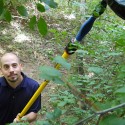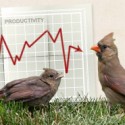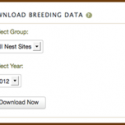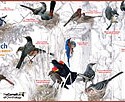 Photo ©
Keith Williams
Photo ©
Keith Williams

Monitoring nests in Sapsucker Woods
Throughout the 2012 breeding season, Jason Martin (NestWatch Project Leader) and Suzanne Beyeler (Research Associate, Department of Natural Resources, Cornell University) have roamed Sapsucker Woods, home of the Cornell Lab of Ornithology, in search of bird nests. Armed with a mirror attached to the end of an extendable pole, they were able to look into nests that were up to 20 feet high. Why? In addition to field-testing the NestWatch protocols and putting our new data entry system through its paces, they were piloting a study examining the impact of recreational trails on bird nesting success.
This summer, Jason and Suzanne monitored 41 open cup nests in Sapsucker Woods. Preliminary results indicate that nests near more heavily used trails were more likely to successfully produce fledglings than those near lightly used trails. This trend was apparent for all species lumped together (11 out of 24 nests were successful near heavily used trails; 3 out of 17 nests were successful near lightly used trails) and for nests of the most common species found, American Robin (heavy: 8 out of 15 successful; light: 1 out of 6 successful). Using trail counters, they determined that the heavily used trails in Sapsucker Woods averaged approximately 140 people per day during the summer, while the more lightly traveled trails were used by about only 20 people per day. Other studies on this topic have found mixed results, but some have suggested that frequent foot traffic can interfere with the activities of nest predators and thus allow more chicks to hatch and grow to maturity. Chipmunks appear to be the most common nest predators in Sapsucker Woods. Nesting success for various species can range widely depending on lots of factors, such as predator density, habitat quality, weather, and the abundance of Brown-headed Cowbirds.

When is the best time to enter data?
While any time is a good time to enter your nesting data, we recommend entering data into NestWatch either immediately after a nesting attempt is completed or soon after nesting season has ended. For most of the U.S., that time is now! We find that it’s helpful to enter your nesting data while your observations are still fresh in your mind. Now is the perfect time to visit NestWatch.org for a little screen time for science. Doing your part as a citizen scientist not only helps us collect far more information about nesting birds than we ever could alone, it guarantees that your data will be preserved in perpetuity with us, no matter what happens to your field notes or your computer files. We’ve compiled our most frequently-asked questions into a handy list to help you get started. Still have questions about our new website? We’re here to help. Somewhere, a researcher is eagerly awaiting your data…don’t delay–there is no time like the present!

Website Update
We’re excited to announce that a personal data download feature has been added to the “Your Data” page. You’ll find options for specifying which data you want to export just below your Quick Summary section. Look at your trends over time, know which nest boxes to tweak, and share your reports with an organization.

Monthly Winner
At the beginning of each month, NestWatch randomly selects one participant to receive a copy of the NestWatch Common Nesting Birds of North America poster. This month’s lucky winner is Bill Apgar. Congratulations, Bill!